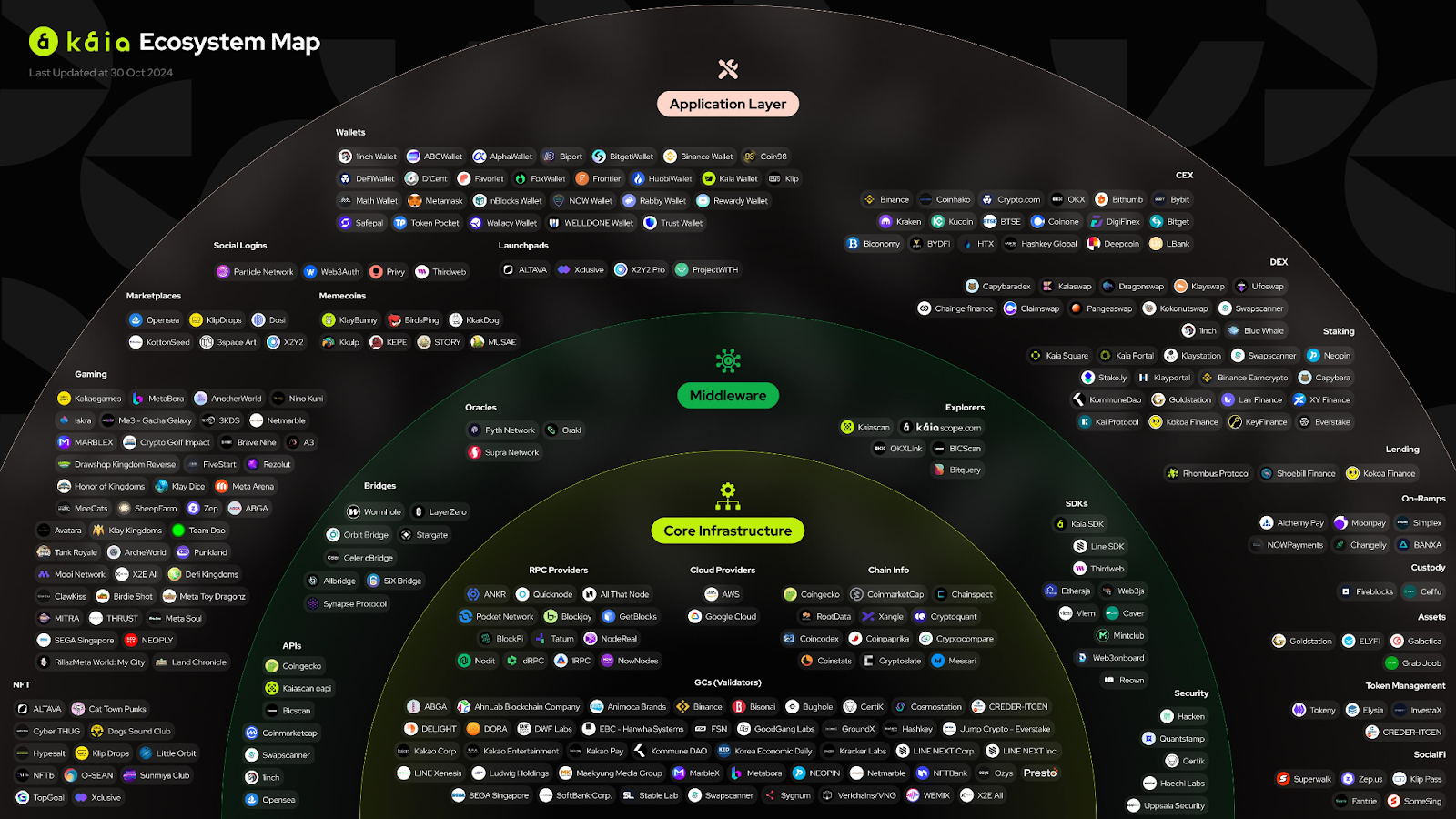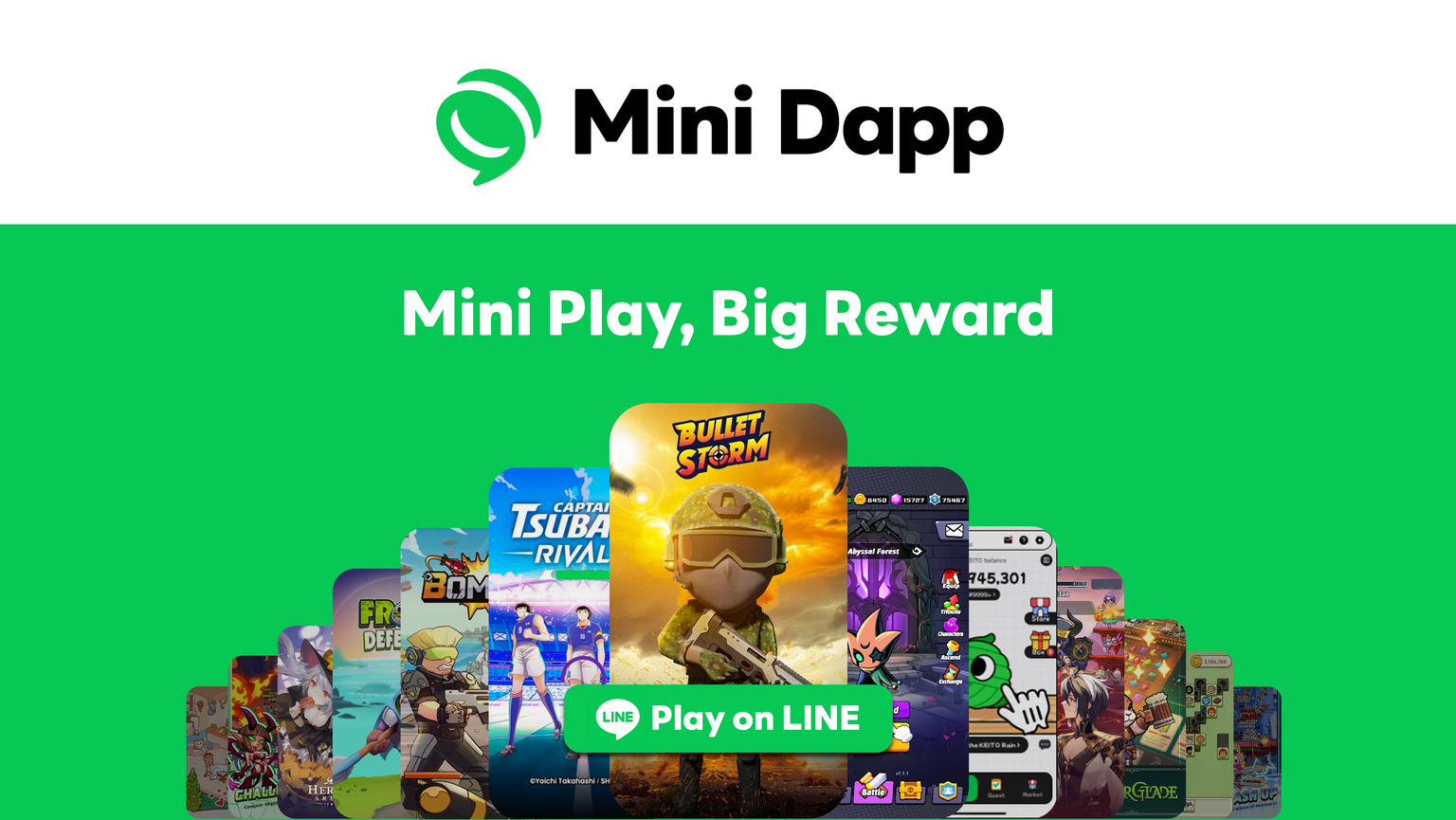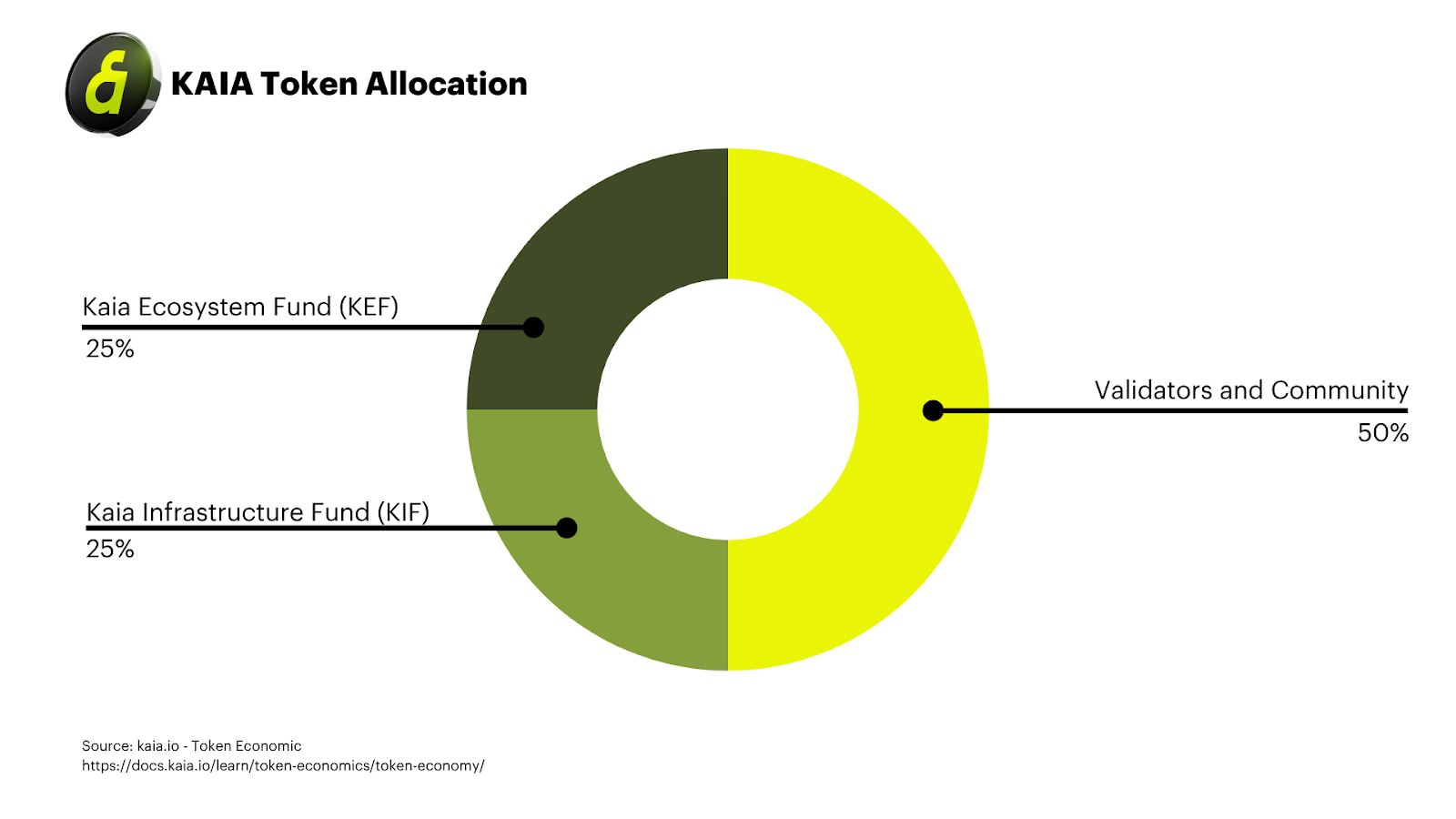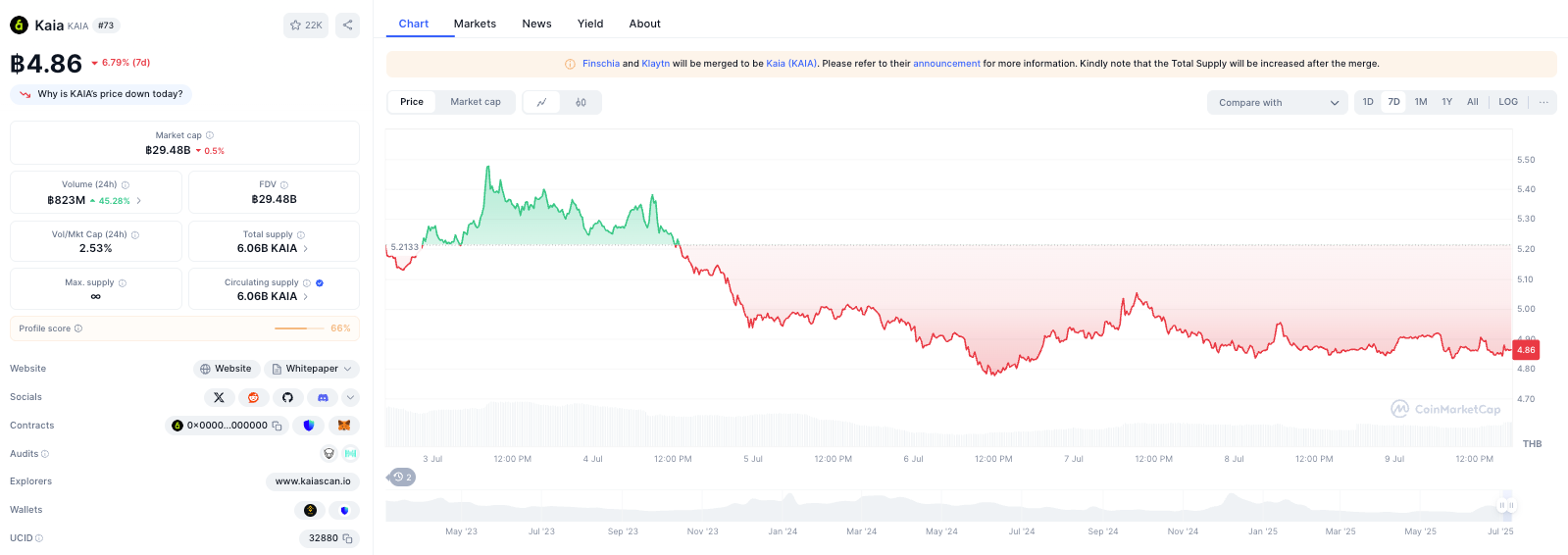บทความ
Kaia บล็อกเชนที่สามารถใช้งานได้ผ่าน LINE ที่จะมาเปิดประสบการณ์ Web3 สู่ผู้ใช้งานกว่า 250 ล้านคน

ในการเคลื่อนไหวครั้งสำคัญที่พร้อมจะพลิกโฉมโลก Web3 ของเอเชีย Kaia ได้ถือกำเนิดขึ้นในฐานะบล็อกเชนสาธารณะ Layer 1 ที่เกิดจากการรวมตัวกันเชิงกลยุทธ์ของ Klaytn ซึ่งได้รับการสนับสนุนจาก Kakao ยักษ์ใหญ่ด้านอินเทอร์เน็ตของเกาหลีใต้ และ Finschia ซึ่งเป็นบริการส่งข้อความ LINE ของญี่ปุ่น โดย Kaia มุ่งมั่นที่จะเป็นรากฐานสำหรับการนำ Web3 มาใช้ในวงกว้าง โดยใช้ประโยชน์จากฐานผู้ใช้จำนวนมหาศาลของบริษัทแม่
Kaia คืออะไร?
Kaia คือ บล็อกเชน Layer 1 ประสิทธิภาพสูงระดับองค์กรที่ออกแบบมาเพื่อความเร็ว ทั้งยังมีความสามารถในการปรับขนาด (Scalability) และการเข้าถึง จุดกำเนิดของ Kaia อยู่ที่การรวมระบบนิเวศบล็อกเชนที่จัดตั้งขึ้นสองแห่ง ได้แก่ Klaytn และ Finschia ซึ่งเป็นการเคลื่อนไหวที่รวบรวมผู้ใช้รวมกันกว่า 250 ล้านคนจากแอปส่งข้อความยอดนิยม KakaoTalk และ LINE การรวมตัวเชิงกลยุทธ์นี้มีจุดมุ่งหมายเพื่อรวมความสามารถของ Web3 เข้ากับอินเทอร์เฟซผู้ใช้ที่คุ้นเคยโดยตรง ช่วยลดอุปสรรคในการเข้าถึงสำหรับผู้ใช้ทั่วไปได้อย่างมาก สถาปัตยกรรมของ Kaia สร้างขึ้นบนกลไกฉันทามติแบบ Byzantine Fault Tolerant (BFT) ทำให้มั่นใจได้ถึงการทำธุรกรรมในเสร็จเรียบร้อยได้ในแบบทันทีและความปลอดภัยที่แข็งแกร่ง
พันธมิตรเชิงกลยุทธ์ของ Kaia จากความร่วมมือระหว่างแพลตฟอร์มสนทนาอย่าง LINE และ Kakao
รากฐานที่แท้จริงของ Kaia อยู่ในพันธมิตรเชิงกลยุทธ์ระหว่าง Kakao และ LINE โดยการลงทุนบนบล็อกเชน โดย Kakao ยักษ์ใหญ่ด้านอินเทอร์เน็ตของเกาหลีใต้ซึ่งเป็นผู้อยู่เบื้องหลังแอปส่งข้อความ KakaoTalk ที่เป็นกำลังหลักที่อยู่เบื้องหลังบล็อกเชน Klaytn ในทำนองเดียวกัน LINE บริการส่งข้อความชื่อดังของญี่ปุ่น ได้ริเริ่มและพัฒนาบล็อกเชน Finschia เป็นที่มาของการรวมตัวกันครั้งสำคัญสู่การเป็น Kaia จากการควบรวมกิจการครั้งสำคัญระหว่าง Klaytn Foundation และ Finschia Foundation การรวมตัวนี้ไม่ใช่แค่การรวมเทคโนโลยีเท่านั้น แต่ยังเป็นการจัดแนวเชิงกลยุทธ์ที่มีจุดมุ่งหมายเพื่อใช้ประโยชน์จากฐานผู้ใช้ขนาดใหญ่ของ KakaoTalk และ LINE มีเป้าหมายที่จะทำให้การผสานรวมกับแพลตฟอร์มการส่งข้อความทั้งสองนั้นลึกซึ้งยิ่งขึ้น ด้วยเอกลักษณ์นี้ทำให้ Kaia สามารถเข้าถึงผู้ใช้ Web3 ที่มีศักยภาพกว่า 250 ล้านคนทั่วเอเชียได้อย่างที่ไม่เคยมีมาก่อน วิสัยทัศน์หลักคือการฝังฟังก์ชัน Web3 อย่างราบรื่นเข้ากับประสบการณ์การส่งข้อความในชีวิตประจำวัน ทำให้แอปพลิเคชันและบริการกระจายศูนย์ใช้งานง่ายและเข้าถึงได้เหมือนการส่งข้อความ ซึ่งจะช่วยผลักดันการนำเทคโนโลยีบล็อกเชนมาใช้ในวงกว้างได้อย่างมาก
คุณสมบัติเด่นของ Kaia
– ประมวลผลได้อย่างรวดเร็ว: Kaia มีเวลาการสร้างบล็อกที่น่าประทับใจเพียง 1 วินาที และความสามารถในการประมวลผลธุรกรรมสูงสุด 4,000 รายการต่อวินาที (TPS) อัตราการประมวลผลที่สูงและการสิ้นสุดธุรกรรมในทันทีนี้มีความสำคัญอย่างยิ่งสำหรับแอปพลิเคชันแบบเรียลไทม์และการทำงานในระดับองค์กร
– ค่าธรรมเนียมธุรกรรมต่ำ: ค่าธรรมเนียมธุรกรรมบน Kaia นั้นต่ำกว่าอย่างมาก ประมาณหนึ่งในสิบของ Ethereum ทำให้เอื้ออำนวยประโยชน์ให้กับนักพัฒนาและผู้ใช้ นอกจากนี้ยังมีคุณสมบัติการมอบสิทธิ์ค่าธรรมเนียม ทำให้แอปพลิเคชันสามารถครอบคลุมค่าธรรมเนียมธุรกรรมของผู้ใช้ ซึ่งช่วยเพิ่มประสบการณ์ผู้ใช้
– ความเข้ากันได้กับ EVM: ความเข้ากันได้เต็มรูปแบบกับ Ethereum Virtual Machine (EVM) ทำให้นักพัฒนาสามารถย้าย Smart contract ที่ใช้ Solidity ที่มีอยู่ได้อย่างง่ายดาย และใช้ประโยชน์จากเครื่องมือการพัฒนาที่คุ้นเคย ซึ่งช่วยเร่งการพัฒนา dApp
– การทำงานร่วมกับ Web2: จุดแข็งหลักของ Kaia คือการรวมเข้ากับแพลตฟอร์มส่งข้อความ Kakao และ LINE อย่างลึกซึ้ง ข้อได้เปรียบที่ไม่เหมือนใครนี้ช่วยให้เข้าถึงผู้ใช้ Web3 ที่มีศักยภาพหลายร้อยล้านคนโดยตรง ทำให้การโต้ตอบบล็อกเชนราบรื่นผ่านอินเทอร์เฟซที่คุ้นเคย
– ความปลอดภัยที่แข็งแกร่ง: Kaia ใช้กลไกฉันทามติ Istanbul BFT ที่ปรับปรุงแล้ว ทำให้มั่นใจในความปลอดภัยของเครือข่ายที่แข็งแกร่งผ่านคุณสมบัติต่างๆ เช่น การตรวจสอบความถูกต้องแบบ MultiSig การเลือกผู้เสนอแบบสุ่มผ่าน Verifiable Random Function (VRF) และการแยกคีย์ผู้ตรวจสอบความถูกต้องและคีย์รางวัล
ระบบนิเวศของ Kaia
ระบบนิเวศของ Kaia ได้รับการออกแบบมาเพื่อส่งเสริมภูมิทัศน์ที่สดใสสำหรับ dApps ต่างๆ โดยมีเป้าหมายที่จะเป็นแพลตฟอร์มชั้นนำสำหรับ
– การเงินแบบกระจายศูนย์ (DeFi): ช่วยให้บริการทางการเงินมีประสิทธิภาพและต้นทุนต่ำ
– เกมและ NFT: รองรับเกมบล็อกเชนที่น่าสนใจและตลาด NFT
– โซลูชันสำหรับองค์กรและการชำระเงิน: จัดเตรียมโครงสร้างพื้นฐานที่เชื่อถือได้สำหรับธุรกิจในการปรับใช้งานบนบล็อกเชน
– แอปพลิเคชันโซเชียลและชุมชน: อำนวยความสะดวกในรูปแบบใหม่สำหรับการโต้ตอบระหว่างกันและการสร้าง Content ที่หลากหลาย

Line Dapp Portal คืออะไร?

LINE Dapp Portal เป็นโครงการสำคัญของ LINE NEXT Inc. (บริษัท Web3 ของ LINE) ที่มุ่งนำแอปพลิเคชันกระจายศูนย์ (dApps) มาสู่ผู้ใช้จำนวนมหาศาลของแอปส่งข้อความ LINE โดยตรเพื่ทำหน้าที่เป็นประตูหรือศูนย์กลางภายใน LINE Messenger ที่ช่วยให้ผู้ใช้สามารถค้นหา เข้าถึง และโต้ตอบกับบริการ Web3 ต่างๆ โดยไม่จำเป็นต้องดาวน์โหลดแอปพลิเคชันแยกต่างหาก
โดย “Mini Dapps” นี้ทำงานบนเครือข่ายบล็อกเชน Kaia เพื่อเป็นโครงสร้างพื้นฐานบล็อกเชนสำหรับ dApps เหล่านี้ นอกจากนี้ยังทำหน้าที่เป็นกระเป๋าเงินในแอป ผู้ใช้สามารถจัดการสินทรัพย์เสมือนจริง ได้รับรางวัล และแลกเปลี่ยน NFT ได้โดยตรงผ่านกระเป๋าเงินที่เชื่อมโยงกับบัญชี LINE ของตน
สำหรับ Dapps บน Mini Dapps นี้ยังมีความหลากหลายไม่ว่าจะเป็น เกม โซเชียลมีเดีย แพลตฟอร์มให้ความรู้ สุขภาพ และเครื่องมือ DeFi ซึ่งผู้พัฒนาได้ตั้งเป้าหมายภายในปี 2025 นี้จะมีโครงการและแอปต่างๆ มากกว่า 1,000 รายการ เพื่ออำนวยความสะดวกในการนำบริการกระจายศูนย์มาใช้ในวงกว้าง โดยเฉพาะอย่างยิ่งในตลาดเอเชียที่ LINE ที่ตัวแอปพลิเคชันได้รับความนิยมอย่างแพร่หลาย
ใครคือผู้ก่อตั้ง?
Kaia เป็นผลมาจากการ ควบรวมระหว่าง Klaytn Foundation และ Finschia Foundation ในขณะที่ Foundation เหล่านี้ได้รับการสนับสนุนจาก Kakao และ LINE ตามลำดับ แต่ Kaia กำกับดูแลโดยสภาที่หลากหลาย บุคคลที่มีความสำคัญได้แก่ Eddie Kim และ Ashwani ซึ่งมีบทบาทสำคัญในการกระจายอำนาจและการวิเคราะห์ข้อมูลของ Klaytn มีส่วนสำคัญในการเป็นผู้นำวิสัยทัศน์และการพัฒนาของ Kaia โดยนำประสบการณ์อันกว้างขวางจาก Web2 สู่โลก Web3
KAIA Token คืออะไร?
โทเคน KAIA เป็น Native Token สำหรับระบบนิเวศ Kaia ทำหน้าที่หลากหลาย
– ค่าธรรมเนียมธุรกรรม: KAIA ใช้เพื่อชำระค่าธรรมเนียมแก๊ส อำนวยความสะดวกในการทำธุรกรรมและการดำเนินการ Smart Contract
— การ Stake: ผู้ถือโทเคนสามารถ Stake KAIA เพื่อเข้าร่วมในกลไกฉันทามติของเครือข่าย ซึ่งมีส่วนช่วยในความปลอดภัยและได้รับรางวัล
— การกำกับดูแล: KAIA ที่ Stake ไว้จะให้สิทธิ์ในการลงคะแนน ทำให้ผู้ถือสามารถเข้าร่วมในการตัดสินใจการกำกับดูแลบนเชน ซึ่งส่งผลต่อการอัปเกรดและข้อเสนอของเครือข่าย
– การโอนมูลค่าระบบนิเวศ: KAIA มีบทบาทสำคัญในการจูงใจทางเศรษฐกิจและรางวัลภายในระบบนิเวศของ Kaia ซึ่งสนับสนุนผู้เข้าร่วมเครือข่ายและโครงการริเริ่มการพัฒนาต่างๆ
การจัดสรรโทเคนและ Tokenomics
Tokenomics ของ KAIA ได้รับการออกแบบมาเพื่อความยั่งยืนในระยะยาวและการเติบโตของระบบนิเวศ อัตราเงินเฟ้อเริ่มต้นต่อปีถูกกำหนดไว้ที่ 5.2% โดย KAIA ที่ออกใหม่และค่าธรรมเนียมธุรกรรม (รางวัลบล็อก) จะถูกจัดสรรดังนี้:

– 50% ให้กับผู้ตรวจสอบความถูกต้องและชุมชน: สิ่งนี้ช่วยกระตุ้นการมีส่วนร่วมและความปลอดภัยของเครือข่าย โดย 20% จัดสรรให้กับผู้สร้างบล็อก และ 80% เป็นรางวัลการ Stake
– 25% ให้กับ Kaia Ecosystem Fund (KEF): กองทุนนี้ทุ่มเทให้กับการส่งเสริมการเติบโตของระบบนิเวศ Kaia ผ่านการลงทุน การให้ทุน และการเป็นพันธมิตรเชิงกลยุทธ์
– 25% ให้กับ Kaia Infrastructure Fund (KIF): กองทุนนี้สนับสนุนการบำรุงรักษาและการพัฒนาโครงสร้างพื้นฐานหลักของบล็อกเชน Kaia อย่างต่อเนื่อง
นอกจากนี้ Kaia ยังใช้โมเดลการเผาโทเคนสามชั้นเพื่อจัดการอุปทานโทเคน โดยเผาตามธุรกรรม (ส่วนหนึ่งของค่าธรรมเนียมจะถูกเผา), การเผามูลค่าสูงสุดที่สกัดได้ (MEV) และการเผาตามธุรกิจ (กระตุ้นให้บริการระบบนิเวศดำเนินการเผา KAIA) โมเดล Tokenomics ที่ครอบคลุมนี้มีเป้าหมายเพื่อสร้างระบบนิเวศที่ยั่งยืนด้วยตนเองและเพิ่มมูลค่าให้กับ Kaia
ข้อมูลน่าสนใจด้านราคาของ KAIA

ข้อมูลจากเว็บไซต์ CoinMarketCap เมื่อวันที่ 9 ก.ค. 2025 เหรียญ KAIA มีมูลค่าตามราคาตลาด (Market cap) ที่ 902,359,198 ดอลลาร์สหรัฐฯ หรือประมาณ 29,497,342,973 บาท
ณ เวลาที่เขียนบทความนี้ เหรียญ KAIA ซื้อขายกันอยู่ที่ราคาประมาณ 0.1488 ดอลลาร์ หรือประมาณ 4.86 บาทต่อ 1 KAIA โดย KAIA เคยทำราคาสูงสุด (All-time high) ที่ 0.415 ดอลลาร์ หรือประมาณ 13.58 บาท ต่อ 1 KAIA เมื่อวันที่ 3 ธันวาคม 2025
อ้างอิง : Kaia Docs, CoinMarketCap
- คริปโทเคอร์เรนซีและโทเคนดิจิทัลมีความเสี่ยงสูง ท่านอาจสูญเสียเงินลงทุนได้ทั้งจํานวน โปรดศึกษาและลงทุนให้เหมาะสมกับระดับความเสี่ยงที่ยอมรับได้
— — — — — — — — — — — — — — — — —

หากคุณยังเป็นมือใหม่ ค้นหาข้อมูลเพิ่มเติมได้ในบทความ “แหล่งความรู้ มือใหม่หัดเทรดคริปโต เริ่มต้นที่นี่” แล้วมาเริ่มต้นเทรดได้วันนี้ที่ Bitkub Exchange → คลิกสมัครเลย
— — — — — — — — — — — — — — — — —
Kaia: Bringing Web3 to Over 250 Million Users Through LINE

Get ready for a big shift in Asia’s Web3 world! Kaia has arrived as a powerful Layer 1 public blockchain, born from a smart merger between Klaytn (backed by South Korean internet giant Kakao) and Finschia (from Japan’s messaging service, LINE). Kaia’s mission? To become the main highway for widespread Web3 adoption, by tapping into the huge user bases of its parent companies. If you’re curious about crypto, or just want to know more, let’s dive into what makes Kaia tick.
What is Kaia?
Think of Kaia as a super-efficient, enterprise-grade Layer 1 blockchain, built for speed, easy scaling, and broad access. Its roots trace back to the joining of two established blockchain ecosystems: Klaytn and Finschia. This move brought together a combined user base of over 250 million from popular messaging apps like KakaoTalk and LINE. The whole idea behind this strategic merger is to weave Web3 seamlessly features directly into user interfaces people already know and love, making it much easier for everyday users to step into the world of Web3. Kaia’s foundation is built on a Byzantine Fault Tolerant (BFT) consensus mechanism, which means transactions are confirmed instantly and the security is rock-solid.
The Power Duo: Kaia’s Alliance with LINE and Kakao
Kaia’s very core is built on the strategic partnership with Kakao and LINE, stemming from their earlier blockchain ventures. Kakao, the South Korean internet titan behind the dominant KakaoTalk messenger app, was the driving force behind the Klaytn blockchain. Similarly, LINE, the widely popular Japanese messaging service, was the brainchild behind the Finschia blockchain.
The birth of Kaia is a direct result of a crucial merger between the Klaytn Foundation and the Finschia Foundation. This wasn’t just about blending technologies; it was a smart strategic move to capitalize on the massive user bases of KakaoTalk and LINE. By joining forces, Kaia directly inherits and plans to deepen its existing integrations with both messaging platforms. This unique position gives Kaia unparalleled access to over 250 million potential Web3 users across Asia. The main vision is to embed Web3 functions smoothly into your daily messaging routine, making decentralized apps and services as simple and accessible as sending a text. This is what will truly drive widespread adoption of blockchain technology.
Kaia’s Standout Features
–Lightning-Fast Processing: Kaia boasts an impressive 1-second block generation time and can handle up to 4,000 transactions per second (TPS). This high speed and instant finality are absolutely key for real-time applications and running things at an enterprise level.
–Low Transaction Costs: Fees on Kaia are significantly lower — about a tenth of Ethereum’s — making it far more budget-friendly for both developers and users. Plus, there’s a fee delegation feature, allowing apps to cover user transaction fees, which makes the experience even smoother.
–EVM Compatibility: Full compatibility with the Ethereum Virtual Machine (EVM) means developers can easily move their existing Solidity-based Smart Contracts over and use familiar development tools, speeding up dApp creation.
–Seamless Web2 Integration: A major strength of Kaia is its deep integration with the Kakao and LINE messaging platforms. This unique advantage provides direct access to hundreds of millions of potential Web3 users, making blockchain interactions feel natural through familiar interfaces.
–Ironclad Security: Kaia uses an enhanced Istanbul BFT consensus mechanism, ensuring strong network security with features like MultiSig validation, random proposer selection via Verifiable Random Function (VRF), and separate keys for validators and rewards.
The Kaia Ecosystem
The Kaia ecosystem is designed to be a thriving space for all sorts of dApps. It aims to be a leading platform for:
–Decentralized Finance (DeFi): Making financial services efficient and affordable.
–Gaming and NFTs: Supporting exciting blockchain games and bustling NFT marketplaces.
–Enterprise and Payment Solutions: Providing a reliable foundation for businesses to build on the blockchain.
–Social and Community Applications: Creating new ways for people to interact and for diverse content to thrive.

What is the LINE Dapp Portal?

The LINE Dapp Portal is a major project from LINE NEXT Inc. (LINE’s Web3 arm) that aims to bring decentralized applications (dApps) right to the huge user base of the LINE messaging app. It acts like a gateway or central hub within LINE Messenger, letting users find, access, and interact with various Web3 services without needing to download separate apps.
These “Mini Dapps” run on the Kaia blockchain, which provides the underlying infrastructure for them. What’s more, it works like an in-app wallet, so users can manage virtual assets, earn rewards, and trade NFTs directly through a wallet linked to their LINE account.
You’ll find a wide range of Dapps on the Mini Dapps platform, from games and social media to educational platforms, health services, and DeFi tools. Developers are aiming high, with a goal of over 1,000 projects and apps by the end of 2025. This push is all about making decentralized services widely adopted, especially in the Asian market where the LINE app is incredibly popular.
Who Founded Kaia?
Kaia is the direct result of the merger between the Klaytn Foundation and the Finschia Foundation. While these foundations were backed by Kakao and LINE respectively, Kaia itself is governed by a diverse council. Key figures like Eddie Kim and Ashwani, who were instrumental in Klaytn’s decentralization and data analytics, have played significant roles in leading Kaia’s vision and development, bringing their vast experience from the Web2 world into Web3.
What is the KAIA Token?
The KAIA Token is the native currency of the Kaia ecosystem, and it has several important roles:
–Transaction Fees: You use KAIA to pay gas fees, which covers the cost of transactions and running Smart Contracts.
–Staking: If you hold KAIA, you can “stake” it to help secure the network’s consensus mechanism and earn rewards in return.
–Governance: Staking KAIA also gives you voting rights, allowing you to participate in on-chain governance decisions that influence network upgrades and proposals.
–Ecosystem Value Transfer: KAIA is crucial for economic incentives and rewards within the Kaia ecosystem, supporting network participants and various development initiatives.
Token Allocation and Tokenomics
KAIA’s tokenomics are designed for long-term health and ecosystem growth. The initial annual inflation rate is set at 5.2%. Newly issued KAIA and transaction fees (block rewards) are distributed like this:

–50% to Validators and Community: This encourages network participation and security, with 20% going to block creators and 80% as staking rewards.
–25% to the Kaia Ecosystem Fund (KEF): This fund is dedicated to boosting the growth of the Kaia ecosystem through investments, grants, and smart partnerships.
–25% to the Kaia Infrastructure Fund (KIF): This fund supports the ongoing maintenance and development of Kaia blockchain’s core infrastructure.
On top of that, Kaia uses a three-tier token burning model to manage supply: transaction-based burning (a portion of fees are burned), Maximal Extractable Value (MEV) burning, and business-based burning (which encourages ecosystem services to burn KAIA). This comprehensive tokenomics model aims to create a self-sustaining and value-increasing ecosystem for Kaia.
Interesting KAIA Price Data

According to CoinMarketCap data from July 9, 2025, the KAIA coin had a market cap of approximately $902,359,198 USD (or about 29,497,342,973 Thai Baht).
As of this article’s writing, KAIA is trading at around $0.1488 USD (or approximately 4.86 Thai Baht per 1 KAIA). KAIA’s all-time high price was $0.415 USD (or about 13.58 Thai Baht per 1 KAIA) on December 3, 2025.
Reference: Kaia Docs, CoinMarketCap
— — — — — — — — — — — — — — — — —

New to crypto? Learn the ropes with our beginner’s guide, ‘Crypto Knowledge for beginners’. When you’re ready, take the next step and start trading today at Bitkub Exchange. Click here to apply!
— — — — — — — — — — — — — — — — —
Disclaimer:
— Cryptocurrency and digital tokens involve high risks; investors may lose all investment money and should study information carefully and make investments according to their own risk profile.
— Past Returns does not guarantee future returns/performance.
ที่มา:
Medium